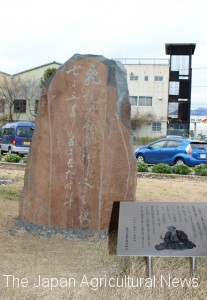Even now spirit of mutual assistance
The thought of Sontoku Ninomiya was handed over to “Hotokusha (organization of mutual reward for virtues).” Hotoku is derived from the “I toku ho toku (reward for virtues by virtues) “, one of teaching in ” Book of Analects”.
The Meiji government gave Sontoku the honorable medal “Jyu-yon-i (the fourth-place medal).” However, if there were no activity of Hotokusha after his death, he might have been forgotten. It was his disciples who made efforts to spread the Hotokusha. Among them, the achievement of Shoshichi Agui (1789-1863) was shining.
Shoshichi was born in Minoge village of Sagaminokuni (Sagami country) (Minoge, Hadano city, Kanagawa prefecture). Although he was adopted of Agui family who run rice business, he dabbled in speculation of rice market and exhausted his wealth. While he borrowed money, and tried to recover his family business, he heard rumors that there was some person to lend money at low interest rates in Yasyu-Sakuramachi town (Mooka city, Tochigi Prefecture). At that time, Sontoku was working there in charge of Shiho program (plans and activities based on hotoku thought) to rebuild branch family and to rescue poor farmers. In response to the introduction of acquaintance, he visited Sontoku at Jinya (magistrates’ office) of Sakuramachi town.
At that time, Sontoku was busy receiving requests for rebuilding from various regions. It was difficult for Shoshichi to even meet Sontoku. However, Sontoku did not say “Go home.” He said, “let him play role of boiling bath.” It might be his Giri-Ninjyo emotion (Righteousness and humanity) that derived from his home region, Sagami country where Shoshichi was also born. Shoshichi waited for future meeting with Sontoku while doing the chore day after day.
In other hand, while overhearing conversations between Sontoku and visitors and Sontoku’s narratives for disciples, Shoshichi understood Sontoku’s greatness. He changed his idea. He learned Sontoku’s teaching by hearing his disciples, and by making scribal of Sontoku’s Shiho program.
Focusing on teaching and spreading Hotokusha

Tanka (Japanese poem of thirty‐one syllables) inscription monument of Shoshichi Agui (Agui-Shoshichi) in front of main gate of JA Hadano (Hadano city, Kanagawa prefecture)
After going back home, Shoshichi tried the “Motone-Akinai (purchase price trade method)” taught by Sontoku. According to the method, at first, you must purchase one bales of brown rice, polish them, and sell them in the purchase price. By such way, you can not get profit. However, you can get one empty container of bale and a little bit of rice in your hand. It becomes a benefit. The method is based on Sontoku’s important teaching, “Sekisyo-idai (importance of every day stacking of little efforts).”
“Business shall success by selling correctly. Seller good, the buyer good. It’s the vital point of business. Sontoku taught so. Shoshichi practiced as taught. ” (“Gido Agui Shoshichi Koden (biography of Shoshichi Agui, Righteousness life)”, Shigeki Yagi). Also, it can be said that the originator of the small profits and quick returns.
His rice shop thrived. After rebuilding the family business, Shoshichi Agui started the activity to let more people know the Hotoku thought of Sontoku. He visited the Enshu region (western Shizuoka Prefecture). At that time, the region also had the same problem as the Kanto region. “There were rural villages facing bankruptcy, and farmers who lost interest in working and spent lazy day-to-day.” (Tatsuya Naramoto, “Sontoku Ninomiya”, Iwanami Shinsho).
Shoshichi spoke also knowledge of Shiho program and agriculture of Sontoku Ninomiya, and struck the hearts of village headman aiming for reconstruction. In 1847 (Koka 4), Enshu’s farmers founded “Shimoishida Hotokusha.” It was the first Hotokusha in Enshu region, and the third one in the nation, after establishment of Odawara Hotokusha (Kanagawa prefecture) and Shimodate Hotokusha (Ibaraki prefecture).
◇
Tanka (Japanese poem of thirty‐one syllables) inscription monument of Shoshichi Agui stands in front of main gate of head office of Agriculture cooperative (JA) of Hadano whose activities area is Hadano city, Kanagawa prefecture.
” Rankui no nagashi mijikashi / hito gokoro / nana ni san tashi go ni go tasu no jyu (Riverside piles are long and short / human mind / 7 adds 3, 5 adds 5, for being 10).” Riverside piles are long and short piles erected on the riverside. Aiming for flood prevention, the riverside piles regulate the flow of river water so as to relieve the momentum of river flow. The poem sings the spirit of mutual aid that each one puts the power together so as to put out 10 powers.
Every year, in order to nurture the mind of the cooperative Shoshichi complained, JA Hadano reserves the educational special reserve fund from the surplus. The cooperative reserves the amount of money that has been calculated at a constant basis, i.e.¥50,000 per 1 member. By the fund for focus on education, the cooperative operates the training courses including seminars and domestic and foreign inspection training.
【Booklet】Beginning of Cooperatives <Sontoku Ninomiya ③> Reputation spread in Enshu(May 23, 2015)


